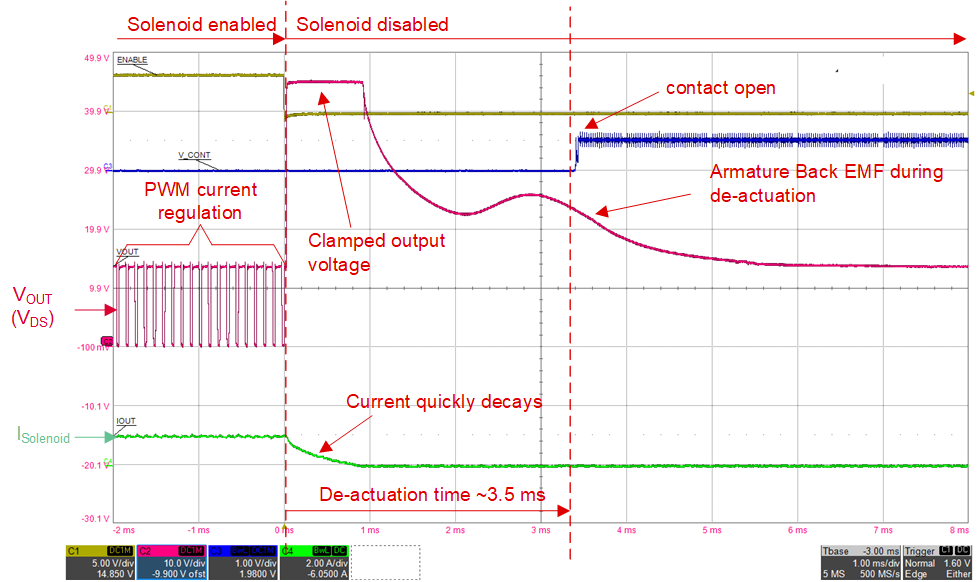SLVAE59A February 2019 – April 2022 DRV8242-Q1 , DRV8243-Q1 , DRV8244-Q1 , DRV8245-Q1 , DRV8343-Q1 , DRV8702-Q1 , DRV8702D-Q1 , DRV8703-Q1 , DRV8703D-Q1 , DRV8803 , DRV8804 , DRV8805 , DRV8806 , DRV8860 , DRV8873 , DRV8873-Q1 , DRV8874 , DRV8874-Q1 , DRV8876 , DRV8876-Q1 , DRV8935 , DRV8955
3.2.1 Freewheeling and Clamping
Freewheeling and clamping are both strategies to dissipate energy stored in the solenoid inductance when the FET turns off. A key difference is current decay speed. Clamping very quickly decays solenoid current by creating a large voltage spike opposite in polarity to solenoid current, voltage larger than with opposing MOSFET recirculation, as in fast decay. Freewheeling is slowly decaying solenoid current by recirculating current through a parallel diode, slowly decaying current.Figure 3-3 shows both freewheeling and clamping implementations.
Clamping involves using as a zener diode or transient voltage suppression diode to rapidly decay current through an inductive load such as solenoid. This can be required for control systems where de-actuation delays are intolerable. The clamping circuit creates a very large voltage opposing the solenoid drive current, and quickly decays current. Figure 3-4 shows expected waveforms when disabling a solenoid using active clamping compared with freewheeling.
When the solenoid is enabled, Vout is low, below 1 V, while solenoid is in the hold phase. When the solenoid is disabled, Vout quickly jumps up to around 40 V (or 3-4 times supply voltage), and the solenoid current quickly drops to 0 A. Also shown above is roughly what the freewheeling voltage and current waveforms would look like. What is not shown is the back EMF generated by the armature when changing state. Figure 3-5 shows an oscilloscope screenshot demonstrating actual voltage and current waveforms during a quick turn-off for a solenoid.
 Figure 3-5 Waveforms Demonstrating Quick
Turn-Off
Figure 3-5 Waveforms Demonstrating Quick
Turn-OffAt the start of the scope shot, the solenoid is in the hold phase. Note the VOUT waveform shows PWM current regulation with VSUPPLY of around 13 V and the steady solenoid current leading up to the disabling of the solenoid. When the solenoid is disabled, VOUT is clamped at roughly 45 V, and the solenoid current decays to zero within one millisecond. After the current has decayed to zero, the armature generates a back EMF during de-actuation. Total time from solenoid disable to de-actuation is about 3.5 milliseconds. Recall in the previous section, the de-actuation time with freewheeling was roughly 10 milliseconds.